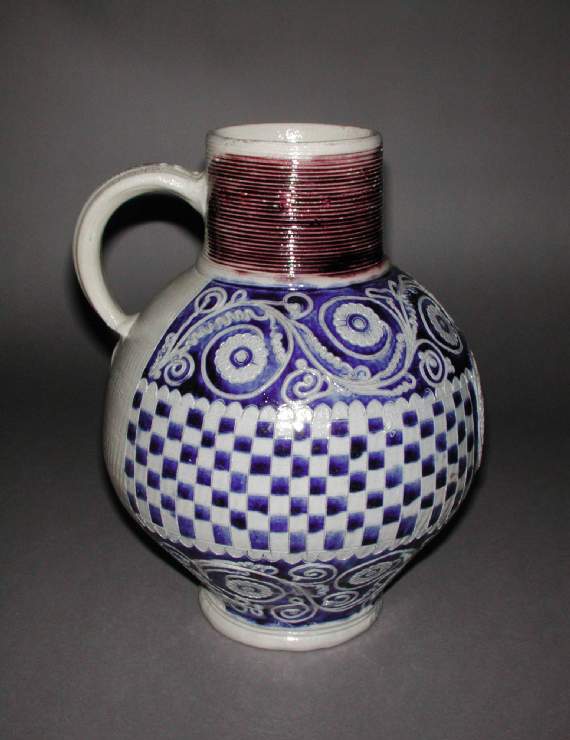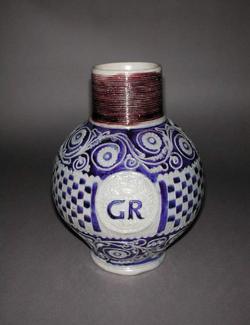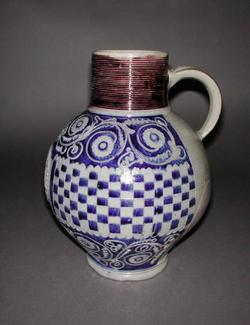Current Location: Gallery 27 (Glaisher)
Maker(s)
Pottery:
Unidentified Westerwald pottery
Entities
Categories
Description
Grey stoneware with incised and applied relief decoration coloured in manganese-purple and cobalt-blue, and salt-glazed: wide horizontal bands of floriated scrolls and chequer pattern, broken on the front by an applied medallion containing the initials GR
Grey stoneware, thrown, with incised and applied moulded relief decoration, painted in cobalt-blue and manganese-purple and salt-glazed. The jug has a globular body with a cylindrical neck and a loop handle with two holes on the top for the attachment of a mount. The circular base is slightly concave underneath. On the front is an applied medallion with the cypher GR in blue for George I or George II, with above, a crown flanked by two birds, and below, a winged cherub's head. On either side of it round the widest part of the body are broad bands of blue and grey chequer pattern. Above and below are bands of formal flowers and tendrils on continuous wavy stems reserved in a blue ground, The neck is rilled horizontally and painted overall in manganese-purple.
Notes
History note: Christie's, 12 February, 1909, part of lot 101, the property of a lady; sold for £10.10s.0d. to Dr J.W.L. Glaisher, FRS, Trinity College, Cambidge.
Legal notes
Dr J.W.L. Glaisher Bequest
Measurements and weight
Height: 31 cm
Width: 24.2 cm
Acquisition and important dates
Method of acquisition: Bequeathed
(1928-12-07)
by
Glaisher, J. W. L., Dr
Dating
George I
George II
Circa
1714
CE
-
1740
CE
Note
The stoneware industry in the Westerwald developed first in the area of three villages, Höhr, Grenzau and Grenzhausen (currently Höhr-Grenzhausen), where potters formed a guild in 1643, and expanded to other villages in the area. Production increased greatly after the end of the Thirty Years War in 1648, and Westerwald stoneware was exported on a large scale to other parts of Europe, including Britain.The medallion on this jug encloses the cipher GR for George I (ruled 1714-27), or George II (ruled 1727-60). A jug with a similar medallion and cipher in the Victoria and Albert Museum, is thought to be more likely to be from the reign of George II, about 1740 (CIRC 88-1919). The jug illustrates the typical colouring of much Westerwald stoneware: a pale grey body with incised and applied decorative motifs coloured in blue derived from cobalt, and manganese-purple before firing and salt-glazing.
School or Style
Baroque
People, subjects and objects depicted
Components of the work
Decoration
composed of
smalt
( produced by fusing cobalt with an alkali, usually potash, and sand, grinding to a powder, and mixing with water)
manganese
Base
Diameter 12 cm
Body
Neck
Surface
Materials used in production
grey
Stoneware
Inscription or legends present
- Text: GR
- Location: On front
- Method of creation: Moulded in relief
- Type: Initials
References and bibliographic entries
Identification numbers
Accession number: C.2047-1928
Primary reference Number: 73047
Old object number: 3025
Stable URI
Audit data
Created: Saturday 6 August 2011
Updated: Tuesday 30 April 2024
Last processed: Tuesday 15 July 2025
Associated departments & institutions
Owner or interested party:
The Fitzwilliam Museum
Associated department:
Applied Arts






